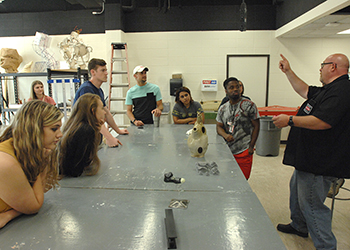3D printing marries high tech and tradition
The advent of affordable 3D printing has taken the fields of engineering and science by storm with its ability to create complex models used for everything from aerospace to biomedical devices. That same technology is also fueling a revolution in art and design.
At Lamar University, 3D printers are found not only in the College of Engineering, but also in the Department of Art and the numbers and uses are growing. Helping with acquiring the technology was a grant from LU’s Center for Innovation, Commercialization and Entrepreneurship. The department now has four 3D printers, as well as specialized furniture to house them.
The technology is not only expanding the opportunities in graphic design, but is especially enriching opportunities for studio artists, Meeks said.
 “Our graduates in painting, drawing, printmaking, sculpture and photography, may find employment because they added in 3D printing skills to their portfolio,” said Donna Meeks, chair of the Department of Art.
“Our graduates in painting, drawing, printmaking, sculpture and photography, may find employment because they added in 3D printing skills to their portfolio,” said Donna Meeks, chair of the Department of Art.
“There are job opportunities opening up for 3D printing artists,” Meeks said. “3D printing, on the practical side, between visual development artists and 3D printing artists, is really opening up new opportunities for people trained in art and design.”
“On the aesthetic level in terms of fine art hybridity, hybrid art forms are really of the most critical importance,” she said. “Expanding our capabilities in 3D printing will give our students the latest production technology to realize their creative vision as well.”
“In painting, you might print a topography that you intend to paint and hang on a wall. You might actually create a mold for a sculpture; or, you may actually create art in that kind of material itself,” she said.
There are yet to be explored ways that 3D printing is going to both facilitate and expedite the creation of works of art, Meeks said.
On the commercial side, students with 3D printing skills will have an edge in finding fruitful employment. “The median salary for individuals with 3D printing experience and a Bachelor of Fine Arts in Studio Art are around $52,000 as research shows,” Meeks said.
“What we’re seeing are opportunities for people artistically trained to go out and be part of those production teams. They have the drawing skills, they have the creative vision, and they can now bring that vision into software where they can model a prototype object and be able to present it to the team lead. It just happens a lot faster,” Meeks said.
Meeks believes the addition of 3D printing to the curriculum will give LU art an edge over other programs in Texas to recruit the best and brightest students.
 This curriculum coincides with growing faculty interest, she said. “In fact, Professor Kurt Dyrhaug already taught a 3D modeling and animation course this summer in which students produced their concepts in digital animation and 3D printing. Its not just ‘make a picture and print.’ There’s a lot of thinking that has to go into deciding whether it’s printable or not.”
This curriculum coincides with growing faculty interest, she said. “In fact, Professor Kurt Dyrhaug already taught a 3D modeling and animation course this summer in which students produced their concepts in digital animation and 3D printing. Its not just ‘make a picture and print.’ There’s a lot of thinking that has to go into deciding whether it’s printable or not.”
More and more incoming freshmen are already familiar with 3D printing and may already have some experience with it. “The technology is becoming so broadly available,” Meeks said.
Currently the department has printers that provide some level of refinement on the surface and surface details, but “ultimately, the art department and others on campus envision a time when we can have very high end output where you’re actually printing the final object, product or prototype to either take to production or take to market.”
Helping with acquiring the technology was a grant from LU’s Center for Innovation, Commercialization and Entrepreneurship. The department now has four 3D printers, as well as specialized furniture to house them.
For larger or more complex objects, it can take “72, 48, 36 hours to print. So, you can see that if you have a class with 16 students you’re going to need several printers.”
The machines will be located in the department’s Sculpture Studio – an inclusion of technology with a very traditional studio art form.
“We’re showcasing that technology is not just on the graphic design side but also on the studio art side,” Meeks said. “I love the marriage of technology with traditional art forms.”
The project is one of eight unique research projects being supported by the CICE through gifts from three LU alumni. Alumnus Jack Gill, Larry Lawson and Anthony George each contributed $10,000 toward eight short-term projects that have expected completion dates of October 1, 2016.
A successful technology entrepreneur, venture capitalist, educator and philanthropist Gill is a 1958 graduate of LU, a Distinguished Alumnus, and holds a Ph.D. in organic chemistry from Indiana University. Lawson attended LU in the 1960s, and, after switching careers from music to health care, founded eCardio Diagnostics in 2004, which became one of the Top 500 fastest-growing in America, 2009-2012. Ernst & Young tapped Lawson as its Health Science Entrepreneur of the Year in 2009. George, a 1988 graduate of LU, was the founder and president of Control Dynamics a company he sold in 2010. He is CEO of Nautical Control Solutions a provider of integrated marine fuel management and vessel monitoring in real-time worldwide.


